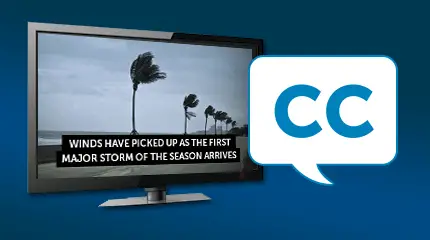
There are as many ways to perform these steps as there are captioning companies, so what works for one company may not work for another. Some companies will do the first few steps simultaneously. They’ll type in one caption, clean it up, set the timing and positioning, and move on to the next one, all through the tape. Others will do these as discrete steps, even using different people. Others will not follow all steps as outlined.
Taking into consideration the time to make the dub of the original master tape for the captioner to work from, all the steps in between, and the time to encode the final master tape, a 1-hour videotape can take anywhere from 8 to 20+ hours to caption.
What is Closed Captioning?
Definition of Captioning
Captioning is the process of converting the audio portion of a film, video, CD-ROM or other production into text which is displayed on a screen or monitor. For deaf and hard of hearing persons, captions not only display words to indicate spoken dialogue or narration, but also include sound effects, speaker identification, music, and other “non-speech” information.
What Are Closed Captions?
One of the captioning types is called closed captions. They are “hidden” unless they are made visible by a decoder or a TV with a decoder chip. They are usually white letters encased in a black box.
Stages In The Captioning Process
Master Copy
- Receive the master or master copy of the videotape from the client.
- Create a VHS work tape copy of the master with a time-code window.
- Make an audio cassette.
Transcript
An accurate transcript is essential for captioning. If a transcript does not exist, it must be created. Transcripts can be submitted in the following formats:
- Disk. It can be in virtually any word-processing application or an ASCII text file.
- Internet. Via Internet file transfer.
- Fax. A text file can be faxed directly to the computer.
- Printed Script. A printed script is useful if it can be scanned accurately. The scanner works best with clean, even-toned, typed scripts.
- Captioner or transcriber.
For direct transcription: The captioner listens to the audio and types what is heard. The captioner can use a transcriber machine with auto backup or captioning software which advances, stops, and backs up the tape in the VCR. Or, to speed up the process, use professional transcription equipment.
For indirect transcription: The captioner retypes from a printed or faxed scrip, scans from a clean printed script, and imports from a word processing file that’s sent on disk or by e-mail. Indirect transcriptions must be compared with the original audio eventually. Most scripts received are not conformed to the audio and must be fixed.
Formatting
The transcript is then:
- Divided into captions. The text is broken into short phrases that will become captions. Where possible, the split is usually by an appropriate breakdown of sentence structure.
- Cleaned of extraneous text but maintains the meaning and essential vocabulary of the message. Music and sound effects are described.
- Checked for accuracy in the area of language mechanics, such as punctuation, grammar, spelling, and others.
Usually, the text appears as two-line pop-up captions; however, some have the capacity to use from one to four lines in pop-up or roll-up fashion. Set the “look” of the captions. Add italics, underlining, colors, speaker identification, brackets around sound effects, music notes around song lyrics, and so forth. Some captioners do this as the script is entered; others go back and add it later.
Time Coding
- A work tape is made.
- Time-code is matched. A time code is assigned to each caption. This tells the caption when to appear on the screen.
- “Grabbed” time codes. “Absorbed” as the tape plays, using the computer keyboard. This is also where the captions may be moved up, down, left or right. Captions are determined where they will appear on the screen. Ensure that essential information is not covered by the captions and that the positioning gives clues as to who is speaking.
Presentation Rate
Presentation rate control, or reading speed, refers to the number of words per minute for each caption. Depending on the grade level of the video, a certain presentation rate is assigned to the captioning job. This is a major process and requires quite a bit of effort. Reading speed can’t be set before the tape is timed exactly, so, it’s necessary to retime the captions. Captions can’t start too early or stay on too late, and if they must be edited, there are a number of rules that must be followed in order to preserve the integrity of the original script.
Positioning
Position the caption to where the person is speaking onscreen. Otherwise, place the caption on the bottom lines at the center of the screen.
Checking and Revision
- Viewing. The video and the captions are played at the same time to show what will appear in the final captioned video.
- Checking and revision. The captions must always be carefully checked for errors before being recorded. Automated tools can perform spelling checks, reading-rate checks, and look for technical timing errors. Actually watch the video with the captions on it in order to catch errors such as captions covering graphics, speaker’s mouth, and others; or appearing too early or late.
- Crunching. A process called “crunching” fuses the time code to the captions. Any problems with conflicting time codes will cause the captions to move faster than the encoder will transmit and as a result, this may cause a gap or incorrectly processed words.
Approval Copy
Create a captioned approval copy of what will be encoded (for broadcast).
Encoding
After the results of the completed captioning job are satisfied, it is transferred to the videotape using a caption encoder.
Captioned Master
- The captioner works closely with an engineer to produce the finished captioned videotape. The captioning file is transmitted from the computer to an encoder, where the original video, time code and new captions are recorded on the desired videotape format.
- Digital masters can be reproduced digitally using a proprietary process for any digital format.
Short Version of the Closed Captioning Process
The captions are activated by a built-in decoder chip to the TV. This technology decodes (figures out) the captioning signal and then captions appear on the screen.
Closed-captioned shows include prerecorded programs such as feature movies, TV series, cartoons, and other programs. A step-by-step procedure lists this process of closed-captioning programs:
- The TV network or home video Company (movie videos) sends a copy of the uncaptioned videotape to a captioning agency.
- The captioner listens to the program dialogue.
- The captioner then types in the captions, ensuring that the dialogue and captions are in synchronization.
- A captioned disk is sent back to the TV network or Home Video Company and is combined with a new videotape, which results in a captioned sub-master tape. This process is called encoding.
- The TV set with the built-in decoder chip decodes (brings out) the captions on the TV screen.








Comments (3)
Jarrod Dorweiler
December 25, 2020Wonderful blog! I found it while surfing around on Yahoo News. Do you have any tips on how to get listed in Yahoo News? I’ve been trying for a while but I never seem to get there! Appreciate it
Michael Ozane
December 30, 2020Thanks for helping out, superb info .
Chester Holgerson
January 10, 2021A further issue is that video games are generally serious naturally with the principal focus on mastering rather than entertainment. Although, it has an entertainment aspect to keep your kids engaged, just about every game is usually designed to improve a specific group of skills or course, such as instructional math or research. Thanks for your write-up.
Comments are closed.